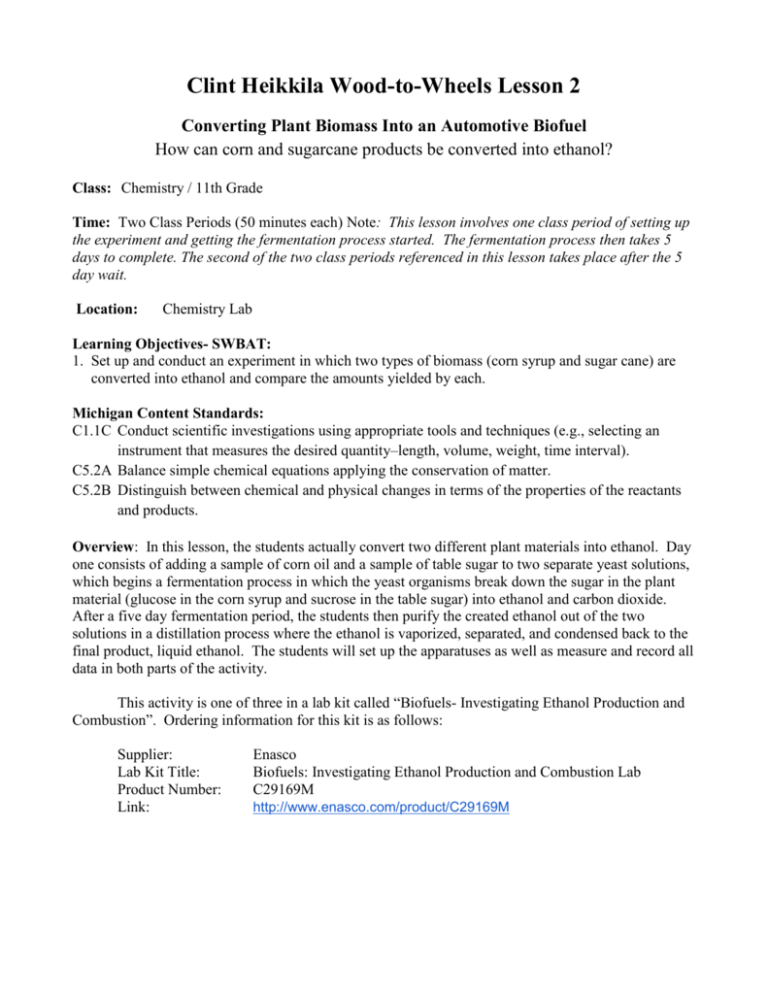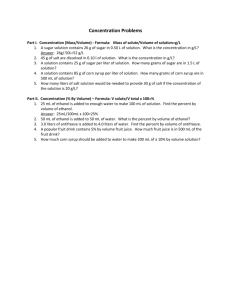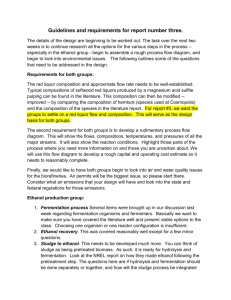Lesson Two Plans
advertisement

Clint Heikkila Wood-to-Wheels Lesson 2 Converting Plant Biomass Into an Automotive Biofuel How can corn and sugarcane products be converted into ethanol? Class: Chemistry / 11th Grade Time: Two Class Periods (50 minutes each) Note: This lesson involves one class period of setting up the experiment and getting the fermentation process started. The fermentation process then takes 5 days to complete. The second of the two class periods referenced in this lesson takes place after the 5 day wait. Location: Chemistry Lab Learning Objectives- SWBAT: 1. Set up and conduct an experiment in which two types of biomass (corn syrup and sugar cane) are converted into ethanol and compare the amounts yielded by each. Michigan Content Standards: C1.1C Conduct scientific investigations using appropriate tools and techniques (e.g., selecting an instrument that measures the desired quantity–length, volume, weight, time interval). C5.2A Balance simple chemical equations applying the conservation of matter. C5.2B Distinguish between chemical and physical changes in terms of the properties of the reactants and products. Overview: In this lesson, the students actually convert two different plant materials into ethanol. Day one consists of adding a sample of corn oil and a sample of table sugar to two separate yeast solutions, which begins a fermentation process in which the yeast organisms break down the sugar in the plant material (glucose in the corn syrup and sucrose in the table sugar) into ethanol and carbon dioxide. After a five day fermentation period, the students then purify the created ethanol out of the two solutions in a distillation process where the ethanol is vaporized, separated, and condensed back to the final product, liquid ethanol. The students will set up the apparatuses as well as measure and record all data in both parts of the activity. This activity is one of three in a lab kit called “Biofuels- Investigating Ethanol Production and Combustion”. Ordering information for this kit is as follows: Supplier: Lab Kit Title: Product Number: Link: Enasco Biofuels: Investigating Ethanol Production and Combustion Lab C29169M http://www.enasco.com/product/C29169M Lesson Core The Guiding Question: How can corn and sugarcane products be converted into ethanol? ● Materials and Equipment Needed (per lab station): (1) Lab kit- “Biofuels- Investigating Ethanol Production and Combustion” *following is a list of needed materials that are not included in the kit PART 1 (2) 250-mL Erlenmeyer flasks (that fit a #7 stopper, stoppers are included in kit) (2) 250-mL beakers (2) immersion thermometers (1) 100-mL graduated cylinder (1) packet of yeast (30) mL of corn syrup (30) mL of table sugar (5) mL glycerol (or other glass tubing lubricant) PART 2 (1) mass balance (2) 50-mL beakers (1) hot plate (1) 25-mL graduated cylinder (1) tub of crushed ice ● Safety precautions: Review lab safety guidelines as pertaining to inserting glass tubing and thermometers into rubber stoppers as well as using hot plates. Students should wear safety glasses. Safe handling of flammable materials should also be reviewed as ethanol is created. ● Advanced Preparation: The students should be able to set up both of the apparatuses used in this lesson as well as measure out all needed amounts of materials. No advanced lab preparation should be needed. ● Engage: Prior to beginning the lab activity, ask the class how a plant material can be converted into an ethanol. From lesson one of this unit, they should know it can be done, but may need a mini-lesson in the fermentation process that explains how it is done. Write the following equations for the fermentation of both sugar sources on the white board and explain that these are the two chemical reactions they will be experimenting with (have the students balance each equation): yeast C6H12O6 (glucose) ----------> 2C2H5OH (ethanol) + 2CO2 + energy yeast C12H22O11 (sucrose) + H2O ----------> 4CH3CH2OH (ethanol) + 4CO2 + energy Before going into the lab, the students are asked to predict any differences they will find in the amounts of ethanol formed from each sugar source. ● Explore: Working in lab groups, the students will then spend the rest of Day One setting up and starting the two fermentation reactions. A detailed procedure for this activity is included with the Lab Kit (copyright restrictions prevent the procedure from being detailed here). After a 5-day fermentation time, explain that while the fermentation is complete, there is not pure ethanol in the flasks at this point, and a distillation process will be used to separate or purify the ethanol. A review of boiling points may be needed to explain this process. The students are then brought back into the lab where they will spend the rest of Day Two setting up and “running” the distillation apparatus. They will measure the amount of ethanol formed from each source and test each for purity. Again, a detailed procedure is included with the Lab Kit. ● Explain and Elaboration: The Lab Kits also come with several copies of a student guide which contains analysis questions the students will answer at the end of the activity (pertaining to comparing the two sugar sources and reasons for choosing one over the other in a “real world” ethanol production facility. Again, copyright restrictions prevent the student guide from being included here). ● Evaluate and Lesson Closure: If time permits, each group could share their results with the rest of the class. Below are questions that can be used to check for understanding of the lab process. Remind the students to save all notes and handouts from this activity as it will be part of a lab report they are to create at the end of the unit (the report will cover all three lab activities conducted in this unit). -What evidence did your group observe of a chemical reaction taking place in the fermentation flask? -How did the rates of ethanol production (how fast it formed) from the corn source and the sugar source compare? Describe the evidence observed that supports your answer. -What color changes did your group observe in the gas-collection beaker? -What do those color changes indicate was happening during the fermentation process? -How do you know the ethanol was separated from the water during the distilling process? -Why was it important to keep the flask within the specific temperature range during distillation? -What mistakes did your group make during the lab procedure? -How did these mistakes affect your lab results? -How could you improve your lab work? -What questions do you have about the lab and your results? Lesson Extension ● Assessment Options: The class discussion at the end of the activity allows the teacher to assess the overall understanding of how a plant source can be converted into ethanol. Asking the questions listed above will help in this assessment. Individually, this will be assessed with the lab report at the end of the unit (have each student answer these questions again in their summaries).






